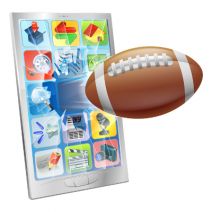There are those in the technology world that argue that professional sports are of marginal importance. Grown men and women, getting paid vast sums of money by fat-cats that make the average successful business owner look like a pauper, to play games that millions of children play everyday. However, according to a poll taken by CNN/USA Today/Gallup, nearly two-thirds of American respondents admitted to being sports fans. In other nations around the world, the sports that fans follow may differ, but percentages are similar to, or exceed those in the U.S.
With so many people watching “the big game,” technology inevitably becomes an essential part of sports. As such, when new technologies come along, they do have a very noticeable effect on major professional sports. From the running shoe to the football helmet to the titanium metal wood, technology has had a profound impact on world of sports; even on those games that haven’t substantially changed because of it.
One of the most emerging technologies that is coming to the forefront is the incorporation of goods that are connected to the Internet. Known as the Internet of Things, the practical applications for the deployment of Internet-connected devices are limited only by the imagination of developers. In fact, the National Football League (NFL) has been at the forefront of using technology to improve fans’ ability to enjoy the game.
The league has begun to do this by equipping every player’s shoulder pads with Radio Frequency identification (RFID) sensors that are about the size of a quarter. Every one of those sensors emits unique radio frequencies that allow the 20 sensor receivers that the NFL has placed in every NFL-used stadium to track each player’s position on the field and each player’s speed, acceleration, and distance traveled in real time.
The plan is to collect this data and use it to power the NFL 2015 app for Xbox One and Windows 10. The app allows users to call up stats for each player that are tied to their “Next Gen Replay” clips posted on the app. By broadening the amount of data that is collected, it gives analysts a more complete understanding of the game. Jill Stelfox, vice president and general manager of Location Solutions for Zebra Technologies, the vendor the NFL uses for the RFID sensors, explains:
What do you need in order to effectively track professional athletes? You need the ability to track a motion in subseconds. Our tags can blink up to 85 times per second.
In addition to the technology you need to capture data, you need to be able to broadcast that data to the server with minimal latency. Zebra sensors accomplish this in about 120 milliseconds and are accurate to six inches, allowing analysts the ability to ascertain what’s happening in under a second.
The NFL is at the forefront of high-end data collection, but is not the only sporting organization to make strides in the use of the Internet of Things. Many of the major U.S.-based professional sporting leagues, including Major League Baseball, Major League Soccer, National Basketball Association, and the National Hockey League have all probed the use of this sensor technology to get a better statistical understanding of the game.
The Internet of Things is here, and it’s not going away. At Vantage Point, we keep tabs on issues at the forefront of technology to best serve our clients. To learn more about technology, the Internet of Things, or how to best use technology to benefit your organization, call us at 225.242.9309 today.

